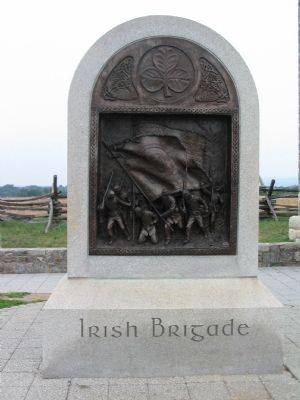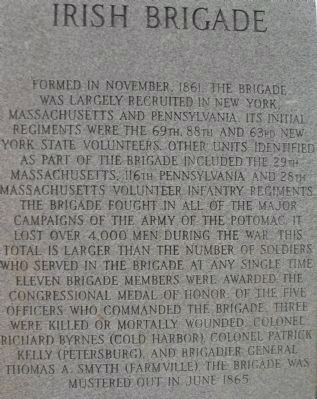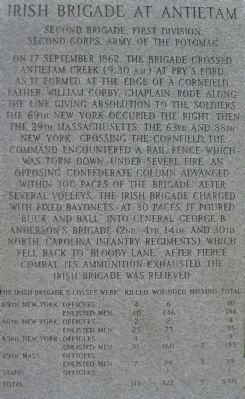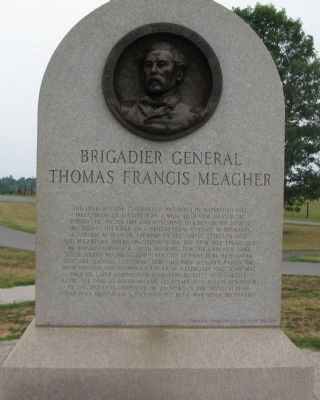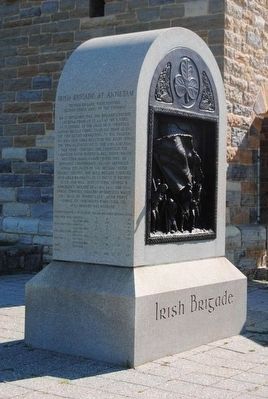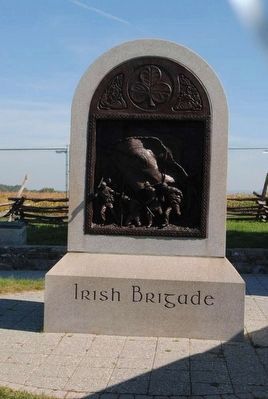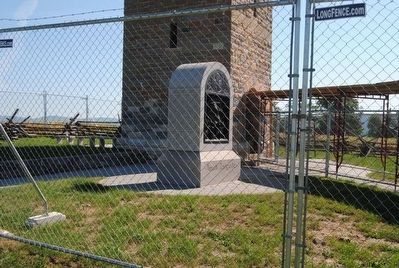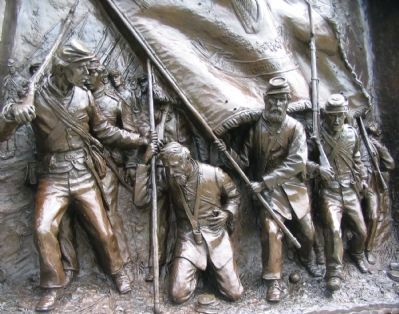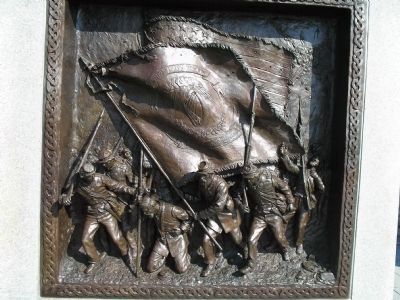Sharpsburg in Washington County, Maryland — The American Northeast (Mid-Atlantic)
Irish Brigade
Formed in November, 1861, the Brigade was largely recruited in New York, Massachusetts, and Pennsylvania. Its initial regiments were the 69th, 88th, and 63rd New York State Volunteers. Other units identified as part of the Brigade included the 29th Massachusetts, 116th Pennsylvania, and 28th Massachusetts Volunteer Infantry Regiments. The Brigade fought in all of the major campaigns of the Army of the Potomac. It lost over 4,000 men during the war. This total is larger than the number of soldiers who served in the Brigade at any single time. Eleven Brigade members were awarded the Congressional Medal of Honor. Of the five officers who commanded the Brigade, three were killed or mortally wounded. Colonel Richard Brynes (Cold Harbor), Colonel Patrick Kelly (Petersburg), and Brigadier General Thomas A. Smyth (Farmville). The Brigade was mustered out in June 1865.
(Left Side):
Irish Brigade at Antietam
Second Brigade, First Division
Second Corps, Army of the Potomac
On 17 September 1862, the Brigade crossed Antietam Creek (9:30 a.m.) at Pry's Ford. As it formed at the edge of a cornfield, Father William Corby, Chaplain, rode along the line giving absolution to the soldiers. The 69th New York occupied the right, then the 29th Massachusetts, the 63rd and 88th New York. Crossing the cornfield, the command encountered a rail fence which was torn down under severe fire. An opposing Confederate column advanced within 300 paces of the Brigade. After several volleys, the Irish Brigade charged with fixed bayonets. At 30 paces it poured buck and ball into General George B. Anderson's Brigade (2nd, 4th, 14th, and 30th North Carolina Infantry Regiments) which fell back to "Bloody Lane." After fierce combat, its ammunition exhausted, the Irish Brigade was relieved.
The Irish Brigade's losses were.
69th New York - Officers [Killed] 4, [Wounded] 6, [Missing] 0, [Total] 10
Enlisted [Killed] 40, [Wounded] 146, [Missing] 0, [Total] 186
88th New York - officers [Killed] 2, [Wounded] 2, [Missing] 0, [Total] 4
Enlisted [Killed] 25, [Wounded] 73, [Missing] 0, [Total] 98
63rd New York - Officers [Killed] 4, [Wounded] 5, [Missing] 0, [Total] 9
Enlisted [Killed] 31, [Wounded] 160, [Missing] 2, [Total] 193
29th Mass - Officers [Killed] 0, [Wounded] 0, [Missing] 0, [Total] 0
Enlisted [Killed] 7, [Wounded] 29, [Missing] 3, [Total] 39
Staff Officers [Wounded] 1
Totals [Killed] 113, [Wounded] 422, [Missing] 5, [Total] 540
(Rear Side):
Brigadier General
Thomas Francis Meager
The Irish Brigade commander was born in Waterford City, Ireland on 23 August 1823. A well-educated orator, he joined the Young Ireland Movement to liberate his nation. This led to his exile to a British penal colony in Tasmania, Australia in 1849. He escaped to the United States in 1852 and became an American citizen. When the Civil War broke out he raised Company K, "Irish Zouaves" for the 69th New York State Milita Regiment, which fought at First Bull Run under Colonel Michael Gorgoran. Subsequently Meagher raised the Irish Brigade and commanded it from 3 February 1862 to 14 May 1863. He later commanded a military district in Tennessee. After the war Meagher became secretary and acting Governor of the Montana Territory. He drowned in the Missouri River near Fort Benton on 1 July 1867. His body was never recovered.
Granite from County Wicklow, Ireland
Erected 1997.
Topics. This historical marker is listed in this topic list: War, US Civil. A significant historical date for this entry is February 3, 1862.
Location. 39° 28.164′ N, 77° 44.168′ W. Marker is in Sharpsburg, Maryland, in Washington County. Marker is on Richardson Avenue, on the left when traveling east. Located beside the Observation Tower overlooking the Sunken Road (Bloody Lane). Touch for map. Marker is in this post office area: Sharpsburg MD 21782, United States of America. Touch for directions.
Other nearby markers. At least 8 other markers are within walking distance of this marker. Major General Israel B. Richardson (here, next to this marker); Hexamer's (New Jersey) Battery (here, next to this marker); War Department Observation Tower (a few steps from this marker); Army of Northern Virginia (a few steps from this marker); a different marker also named Army of Northern Virginia (a few steps from this marker); a different marker also named Army of Northern Virginia (a few steps from this marker); September 17, 1862 (Continued) (a few steps from this marker); a different marker also named September 17, 1862 (Continued) (a few steps from this marker). Touch for a list and map of all markers in Sharpsburg.
Regarding Irish Brigade. This marker is included on the Sunken Road or Bloody Lane Virtual Tour by Markers see the Virtual tour link below to see the markers in sequence.
Related marker. Click here for another marker that is related to this marker.
Also see . . .
1. Irish Brigade Monument. National Park Service site detailing the Irish Brigade monument. (Submitted on February 17, 2008, by Craig Swain of Leesburg, Virginia.)
2. The Irish Brigade. Order of battle from Antietam on the Web. (Submitted on February 17, 2008, by Craig Swain of Leesburg, Virginia.)
3. Irish Brigade History. (Submitted on February 17, 2008, by Craig Swain of Leesburg, Virginia.)
4. Ron Tunison Historical Sculptures. Ron Tunison was the sculptor of the Irish Brigade Monuments. See all of Ron Tunison's historical monuments here. His statue of Patrick Cleburne is not included on the page. (Submitted on July 25, 2015, by Brandon Fletcher of Chattanooga, Tennessee.)
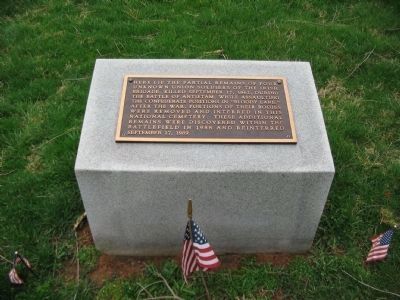
Photographed By Craig Swain, April 6, 2008
10. Remains of Unknown Irish Brigade Soldiers
In the nearby National Cemetery is this reminder that the battlefield became the final resting place of many soldiers:
Here lie the partial remains of four unknown Union soldiers of the Irish Brigade, killed September 17, 1862, during the Battle of Antietam, while assaulting the Confederate positions in "Bloody Lane." After the war, portions of their bodies were removed and interred in this National Cemetery. These additional remains were discovered within the battlefield in 1988 and reinterred September 17, 1989.
Here lie the partial remains of four unknown Union soldiers of the Irish Brigade, killed September 17, 1862, during the Battle of Antietam, while assaulting the Confederate positions in "Bloody Lane." After the war, portions of their bodies were removed and interred in this National Cemetery. These additional remains were discovered within the battlefield in 1988 and reinterred September 17, 1989.
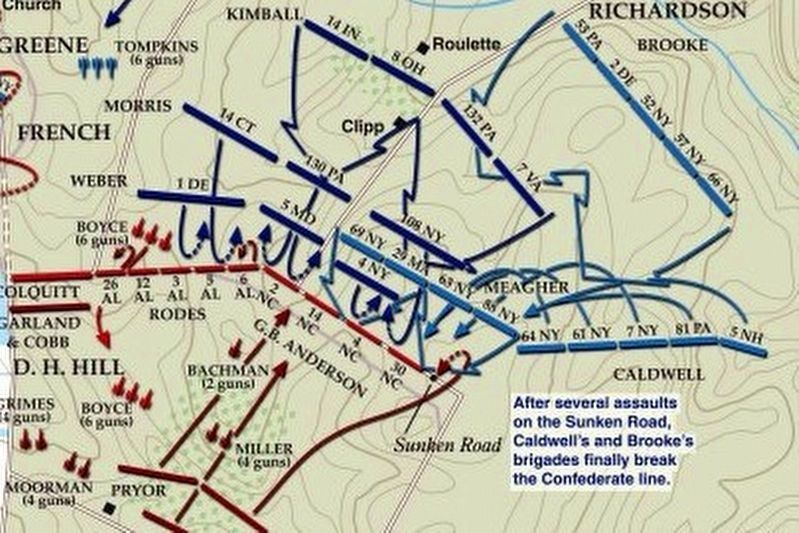
via American Battlefield Trust, unknown
11. Sunken Road or Bloody Lane Virtual Tour by Markers.
A collection of markers interpreting the action of during the Battle of Antietam around the Sunken Road.
(Submitted on February 23, 2008, by Craig Swain of Leesburg, Virginia.)
Click for more information.
(Submitted on February 23, 2008, by Craig Swain of Leesburg, Virginia.)
Click for more information.
Credits. This page was last revised on April 3, 2022. It was originally submitted on February 17, 2008, by Craig Swain of Leesburg, Virginia. This page has been viewed 1,969 times since then and 25 times this year. Photos: 1, 2, 3, 4. submitted on February 17, 2008, by Craig Swain of Leesburg, Virginia. 5, 6, 7. submitted on September 27, 2015, by Brian Scott of Anderson, South Carolina. 8. submitted on July 11, 2009, by Craig Swain of Leesburg, Virginia. 9. submitted on February 22, 2008, by Bill Coughlin of Woodland Park, New Jersey. 10. submitted on April 20, 2008, by Craig Swain of Leesburg, Virginia. 11. submitted on April 3, 2022, by Larry Gertner of New York, New York.
